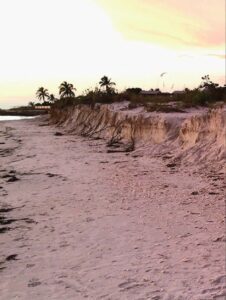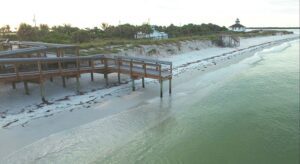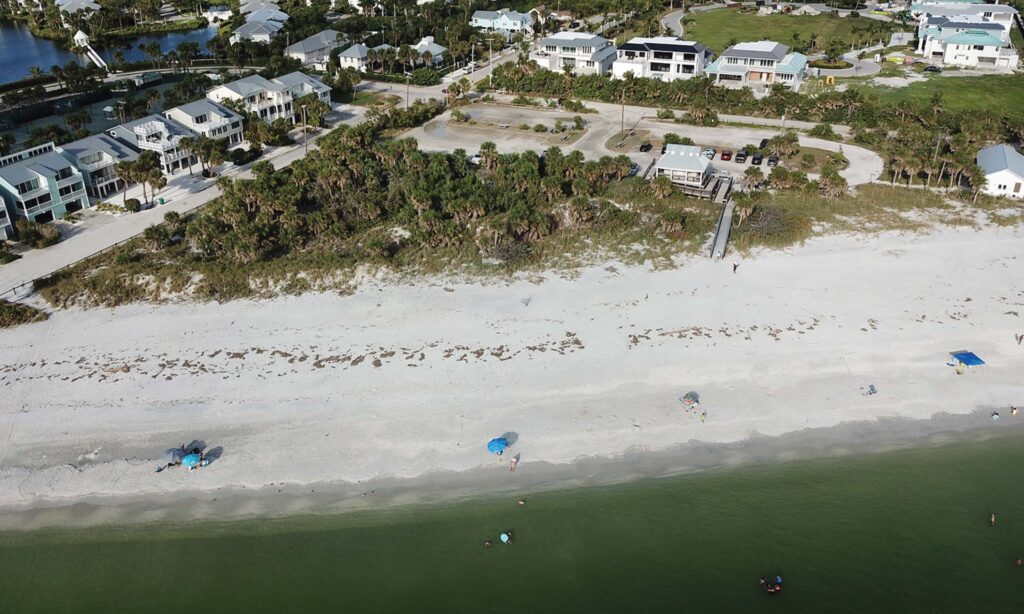A lack of south end dunes has led to a lot of flooding … so what can be done?

Back in July of 1967, the headline in the News-Press of Fort Myers was, “What to Do About Eroded Tip of Boca Grande.”
Then, as now, islanders were looking to beach nourishment to help prevent erosion on the southern tip of Gasparilla Island. At that time, the Boca Grande Conservation Council, headed by Homer Addison of The Temptation, was in favor of establishing a park at the tip of the island, as the Lighthouse was for sale from the Coast Guard through the General Services Administration. It seemed an ideal solution; the only challenge being the “erosion problem.”
Six decades later, the issue of erosion, while not fixed, is regularly addressed through a mix of federal, local and tourist tax monies. Gasparilla, and indeed all of the Gulf of Mexico islands in Florida, are under regular schedules for replenishment. But what is also a challenge is the flooding at the tip of the island, which hit the south end’s streets and historic buildings during hurricanes Irma, Ian and Idalia.

“The flooding is always a thing,” said Rachel Johnson, who lives at the circa 1895 Quarantine house at the corner of Belcher Road. “Even during a good rainstorm, it will flood.”
Currently, Gasparilla Island’s beaches are scheduled for renourishment in 2025, according to a May report by the Florida Department of Environmental Protection. But one issue that missed the most recent replenishment in 2019 was the dunes at the Gasparilla Island State Park, which help protect the end of the island from flooding. The dunes protecting the Amory Chapel disappeared during Hurricane Irma in 2017 and are in a constant state of change in each storm that passes through.
“You can’t stop the ocean from doing what it does,” said Johnson.
In June of 2019, the Boca Beacon reported that dune replenishment at Gasparilla Island State Park was completely left out of the process, leaving the historic buildings on the tip of the island exposed. At the time, the then park manager told the Beacon that the areas were not included because the dunes were expected to fill in with the movement of the new sand.
That has not happened, and during Hurricane Ian and Hurricane Idalia, Gulf of Mexico waters had no barrier into the Amory Chapel.

On the south end, officials have met with residents about fixing simple drainage issues, including a street drain that runs into the Boca Bay development. Boca Beacon Publishers Dusty and Cheryl Hopkins live on Belcher and have witnessed first-hand the flooding. Lee County has worked on cleaning the culvert. That storm drain cleaning helps with the regular rains on the island but leaves unresolved the danger of flooding from storms. The newer developments like Boca Bay and Hill Tide Estates were constructed with modern drainage systems, and at higher elevations.
Dune Ideas
Across the nation, and particularly in Florida, there are new ways of looking at preserving beaches and dunes.
The issue is not just the need for rebuilding dunes, but how they can be rebuilt and maintained.
Hallie Fischman is a Ph.D. student studying dune ecology at the University of Florida’s Center for Coastal Solutions, part of the Herbert Wertheim College of Engineering. Her recent research work on the East Coast of Florida includes using diverse plants to stabilize dunes. The University of Florida research project is looking at ideal plant mixes that can help dunes stabilize faster and stronger, moving away from the rote process of just putting some sea oats atop newly created dunes.
“We really transitioned to these monocultures when we tried to maintain what was there,” said Fischman, of the bias toward sea oats. “We just didn’t think about some of the other interactions that are important.”
For instance, when planting a dune one would consider all the seasons and the idea of plant succession. Panica grass, a sort of millet also known as bitter panicum or Panicum amarum, is a native plant that can add to species interaction as well as harden the dune through different seasons.
“People in Florida love their sea oat dunes,” said Fischman. “But panica might recover faster after planting.”
A challenge for Florida is that what works in one place may not work in another. And the bias toward what worked sort of well before makes for a bias against trying new methods, Fischman said.
“You want to know what’s going to do better than what the alternative is,” said Fischman, who does not have prescriptive answers for Gasparilla Island.
In spite of the challenges, she is encouraged that the Army Corps of Engineers is beginning to embrace new ideas as sea levels rise.
The Army Corps now has a website, ewn.erdc.dren.mil, to promote the ideas in the new field of coastal science entitled engineering with nature.

“It’s a very rapidly advancing science,” said Fischman.
In the study of dunes, there are also small-scale solutions that can be interim steps between major dune and beach renourishment projects.
“Sand fences are an easy one,” said Fischman. ”As used in hundreds of Atlantic and Gulf of Mexico beach towns, sand fences are placed in V or Z diagonal patterns in the sand, with breaches in the middle to allow for sea turtle nesting.
The dune builds atop the fence, and it is buried in the process. The fence also helps to keep visitors off of the dunes as they build.
“It works the same with snow or with sand,” said Debbie Page, of the firm Louis Page Inc. of Whitinsville, Mass. The company, founded in 1893, is the nation’s oldest movable fencing company that provides supplies for farms, towns and highway departments. She likens the sand fence to a child lying on a windy beach.
“If they sit there long enough, they are covered in it,” said Page.
Massachusetts uses sand fences for building frontal ocean dunes that can help control erosion from wave overwash and flooding. The dunes also prevent sand from blowing off of disturbed areas onto roads or adjacent property, which is an issue on the south end.

For protection across the island, Johnson is an advocate for any natural structures or installations that might reinvigorate the health of Boca Grande beaches.
“It would be great to do a little dune restoration,” said Johnson. “It would definitely be a plus. It’s going to help hold the beach together.”
“That’s a big part of Boca Grande,” said Johnson. “It’s dunes and dune vegetation.”

Related Recent Stories
- Q&A with Dr. John Fletemeyer, beach erosion expert (Jan. 12, 2024)
- Shore thing: Sand erosion on the Gulf Coast (Oct. 19, 2023)
- Tourist Development Tax assists barrier island parks (Oct. 12, 2023)
- Gasparilla Island State Park gets regrade, imported sand (Dec. 21, 2023)
Previous Stories
- Permit process causing delays for shoreline projects (Nov. 13, 2018)









